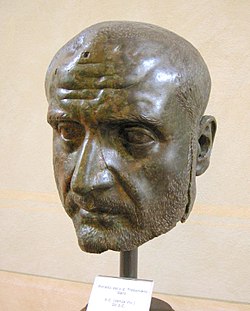|
Trebonianus Gallus - Roman Emperor: 251-253 A.D. -
Bronze 26mm (10.5 grams) Struck at the Roman colonial city of Viminacium in
the province of Moesia Superior 251/252 A.D.
Reference: Varbanov 195. -
IMP C VIBIO TREBON GALLO AVG Laureate draped bust right.
P M S COL VIM, Moesia standing facing between lion & bull, AN XII (year AD
251/252) in ex.
* Numismatic Note: The bull and the lion represent the seventh
Claudian legion stationed at the city.
You are bidding on the exact item pictured,
provided with a Certificate of Authenticity and Lifetime Guarantee of
Authenticity.
Legio septima Claudia Pia Fidelis (Seventh Claudian
Legion) was a
Roman legion. Its emblem, as well as of all Caesar's legions, was the bull,
together with the lion.[citation
needed]
The 7th, along with the
6th,
8th &
9th were all founded by Pompey in Spain in 65 BC.[1]
They[citation
needed] were ordered to
Cisalpine Gaul around 58 BC by
Julius Caesar, and marched with him throughout the entire Gallic Wars.
Legio VII was one of the two legions used in
Caesar's invasions of Britain, and played a crucial role in The
Battle of Pharsalus in 48 BC, and it existed at least until the end of the
4th century, guarding middle
Danube.
Tiberius Claudius Maximus the Roman soldier who brought the head of
Decebalus to emperor
Trajan was serving in Legio VII Claudia.
Viminacium was a major city of the
Romanann province of
Moesia (today's
Serbia), and the capital of
Moesia Superior. Viminacium was the base camp of
Legio VII Claudia, and hosted for some time the
IIII Flavia Felix. It was destroyed in 440 by the
Huns, but rebuilt by
Justinian I. During
Maurice’s Balkan campaigns, Viminacium saw destruction by the
Avars in 584 and a crushing defeat of Avar forces on the northern Danube
bank in 599, destroying Avar reputation for invincibility.
Today
Kostolac, a small
Serbian town on the
Danube river, is located where Viminacium used to be.
 Gaius
Vibius Trebonianus Gallus (206 - August, 253), was
Roman
Emperor from 251 to 253, in a joint rule with his son
Volusianus. Gaius
Vibius Trebonianus Gallus (206 - August, 253), was
Roman
Emperor from 251 to 253, in a joint rule with his son
Volusianus.
Gallus was born in Italy, in a family with respected ancestry
of
Etruscan
senatorial background. He had two children in his marriage with
Afinia Gemina Baebiana: Gaius Vibius Volusianus, later Emperor, and a
daughter, Vibia Galla. His early career was a typical
cursus honorum, with several appointments, both political and military.
He was
suffect consul and in 250 was nominated governor of the
Roman province of
Moesia Superior,
an appointment that showed the confidence of emperor
Trajan Decius in him. In Moesia, Gallus was a key figure in repelling the
frequent invasion attacks by the
Gothic tribes of
the Danube and
became popular with the army, catered to during his brief Imperial rule by his
official image: military haircut, gladiatorial physique, intimidating stance (illustration,
left).[1]
In June 251, Decius and his co-emperor and son
Herennius Etruscus died in the
Battle of Abrittus, at the hands of the Goths they were supposed to punish
for raids into the empire, largely owing to the failure of Gallus to attack
aggressively. When the army heard the news, the soldiers proclaimed Gallus
emperor, despite
Hostilian,
Decius' surviving son, ascending the imperial throne in Rome. Gallus did not
back down from his intention to become emperor, but accepted Hostilian as
co-emperor, perhaps to avoid the damage of another civil war. While Gallus
marched on Rome, an outbreak of
plague struck the city and killed young Hostilian. With absolute power now
in his hands, Gallus nominated his son Volusianus co-emperor.
Eager to show himself competent and gain popularity with the
citizens, Gallus swiftly dealt with the epidemic, providing burial for the
victims. Gallus is often accused of persecuting the
Christians, but the only solid evidence of this allegation is the
imprisoning of
Pope Cornelius in 252.
Like his predecessors, Gallus did not have an easy reign. In
the East, Persian Emperor
Shapur I
invaded and conquered the province of
Syria, without any response from Rome. On the Danube, the Gothic tribes were
once again on the loose, despite the peace treaty signed in 251. The army was
not long pleased with the emperor, and when
Aemilianus,
governor of Moesia Superior and Pannonia, took the initiative of battle and
defeated the Goths, the soldiers proclaimed him emperor. With a
usurper threatening the throne, Gallus prepared for a fight. He recalled
several
legions and ordered reinforcements to return to Rome from the
Rhine frontier.
Despite these dispositions, Aemilianus marched onto Italy ready to fight for his
claim. Gallus did not have the chance to face him in battle: he and
Volusianus
were murdered by their own troops in August 253, in
Interamna (modern
Terni).

Bronze of Gallus dating from the time of his reign as
Roman Emperor, the only surviving near-complete full-size 3rd century Roman
bronze (Metropolitan
Museum of Art)[2]
|